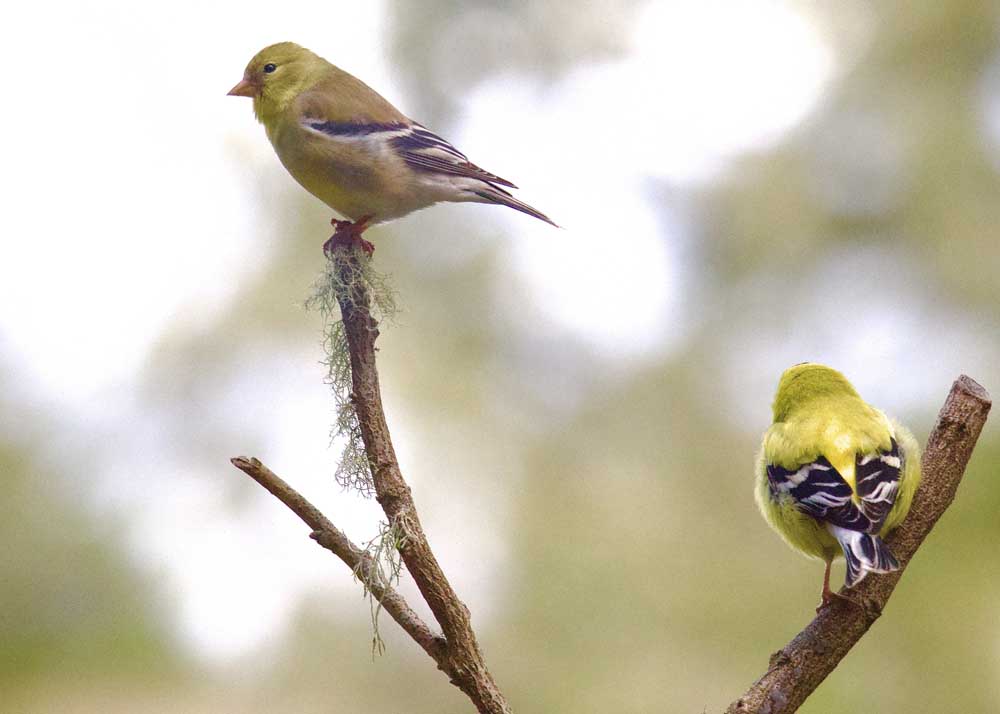Birding: All is quiet on the ‘Western Front’
Published 7:52 am Thursday, May 9, 2024

- This pair of American goldfinch came in for a meal this morning. They have their eyes on a squirrel buster feeder filled with their favorite seeds — small black sunflower seeds.
The month of May has just begun. Our bird migration peak was predicted to be between May 3 and 8. Many of our spring migrants have arrived but there seems to be quite a few species that have not. Some of our spring and summer residents are on nests already or are in the process of building or renovating! Cliff swallows, for example, are beginning to construct their nests under the eaves of the Oysterville Church. Great blue herons are renovating, tree swallows are building and female mallards are incubating their eggs. Canada geese, bald eagles and other raptors are incubating eggs.
A drive on Peninsula roads produces very few birds these days. Savannah, white-crowned, brown-headed cowbird, western meadowlark, and dark-eyed juncos are the birds I am seeing most frequently but in very small numbers. American white pelicans are gathering in Young’s Bay, but again not as many compared to last year at this time. The biggest surprise of all was to see three fledgling killdeer at the Ilwaco Harbor.
The most exciting sighting for early May is the fork-tailed storm petrels being seen at Cape Disappointment. Some birders are noticing one bird, while others have reported up to four petrels at once. Directions given on eBird indicate that it one could see them from Benson Beach looking toward the jetty or from elsewhere where you can see the ocean near or out from the jetty. A few birders have been seeing them in the ocean just below the North Head.
Petrels are small birds seen over the open ocean. They are considered rare here. The fork-tailed storm petrel has only been recorded in the fall according to Willapa National Wildlife Refuge checklist. By the checklist definition, rare means that a bird is seen at intervals of two to five years. The Pacific County checklist indicates that over all in the county, fork-tailed storm petrels are uncommon.
When birds seem nowhere to be found, it is a good idea to sit and watch in your favorite birding patch such as your yard, a field, a harbor, etc. and let the birds come to you! We did exactly that today at the Ilwaco harbor. It wasn’t long before a pair of goldfinch posed for a photo or two. Great blue herons were everywhere in the grassy wetland, a few mallards were foraging too, and a few small flocks of shorebirds flitted along the shoreline of Baker Bay. A white-crowned sparrow, a pair of song sparrows and a savannah sparrow also stopped by. From another observation point where we sat looking for at least twenty minutes we saw a foraging horned grebe in breeding plumage and a double-crested cormorant looking for dinner. I was hoping to see purple martins at the nesting boxes on posts in the harbor, but like many other species they haven’t arrived yet. For the last five years or so they have arrived at the end of April.
The dawn chorus in the yard has barely begun. Just a few singers are singing for mates or marking territories, including the varied thrush, the northern flicker, the American robin, and the purple finch. I can hardly wait for the arrival of the olive-sided flycatcher, Swainson’s thrush, orange-crowned warbler, and the Wilson’s warbler to join the chorus. Soon our permanent residents will also add their voices. Black-capped chickadees, chestnut-backed chickadees, song sparrows, and spotted towhees along with others will all be part of the performance.
Migrants are still on the move, especially shorebirds. Hundreds of dunlin, western sandpipers and long-billed dowitchers in breeding plumage can be seen in the wetlands of the peninsula and on mudflats. A large flock of western sandpipers were loafing in the yard at the Port of Peninsula where the oyster shells are piled. They were lounging around the edges of a few large puddles that formed after the rain of the last few days.
For the last few weeks all has been quiet on the western front. The birds are late this year. Soon the dawn chorus will be loud and boisterous again and parents will be busy building nests and raising young. The quietness will be but a memory! Happy birding!








